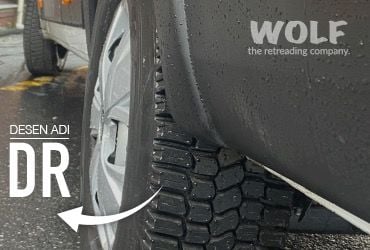What is Tyre Retreading?

The tyres of the vehicles we use are the most critical component that affects basic elements such as road grip, braking performance and driving comfort. In recent years, "tyre retreading" technology has become increasingly popular in order to increase the durability of tyres, extend their life and make them suitable for some aesthetic preferences.
What is Tyre Retreading?
Tyre retreading is the process of adding different types of materials to the existing tyre surface of carcass tyres that meet various criteria and generally have a tread depth of less than 5 mm. This addition process can increase the durability of the tyre, add special patterns and colors, or make it suitable for situations such as offroad.
History of Tyre Retreading
The history of tyre retreading goes back as far as vehicles. In the periods when comfortable automobiles were not yet used, the foundations of the treading process were laid by using leather, cloth and similar materials for horse carriages. With industrial developments, this process has become more sophisticated.
Which tyres can be retreaded?
Retreading can be applied to any tyre that meets minimum quality standards and is approved by experts on issues such as the general condition of the tyre, surface depth, etc. Tyre retreading can also be applied due to tyre pattern requirements for special areas such as offroad.
What is Cold Retreading?
In the cold retreading process carried out with low temperature and pressure, these values are very close to the values under the operating conditions of the tyre. Thus, the same tyre can be retreaded more than once.
What is Hot Retreading?
The hot retreading process, which has been applied since the 1920s, is the most preferred retreading method today. The process begins with experts determining whether the tyres are suitable for retreading and trimming the carefully selected tyres, known as carcasses in the industry, with a scraping machine. The deformed parts on the tyre are cleaned, and after the necessary repairs are made, uncooked patternless rubber is wrapped with cement on the part called the tread, with the help of a machine.
It is then placed in a steel mold with a rubber pattern on it and baked at high temperature at 160 degrees and 15 bar pressure. It is impossible for air bubbles to remain between the rubber and the carcass under the high pressure applied. The pattern of the mold will now be the pattern of the tyre.
Is Tyre Retreading Safe?
Retreading processes carried out in authorized facilities with UN/ECE R 108 and R 109 standards are as safe as new tyres. After the process, the tyres lose nothing in their performance, braking distance and comfort.
Are retreaded tyres prohibited?
One of the biggest misconceptions about retreaded tyres is that this process is illegal. As long as the tyre retreading process is carried out in ministry-approved facilities that apply UN/ECE R 108 and R-109 regulation, it will not pose any legal problems.
Do retreaded tyres pass inspection?
Certainly! Retreaded tyres made in authorized facilities will not cause any problems during inspection as long as they are the appropriate size and direction of rotation for your vehicle.
What are the advantages of retreaded tyres?
Tyres renewed with the retreading method are more economical and at least 5 times more environmentally friendly than new ones.
You can contact ZQ Tyres experts, who provide tyre retreading services under the WOLF Retreading Company brand, through this link .
